Table of contents
Create a culture that means business™
Schedule a demo with an Achievers solution expert today.
Employee feedback tools have come a long way from annual surveys and dusty suggestion boxes. Today’s tools are smarter, faster, and built to help HR teams actually act on what they hear. And that’s a big deal — because when employees feel heard, engagement rises, retention climbs, and your culture gets stronger by the day.
In this blog, we’re rounding up 15 of the best employee feedback tools out there for 2026 — platforms designed to capture real-time insights, spark meaningful conversations, and give you a clearer picture of how your people really feel.
What to look for in employee feedback tools
Not all feedback tools are created equal — and not all will give you the insight you actually need. The best ones go beyond surveys to offer a full picture of how employees feel, what’s driving their experience, and where to focus next.
Here are five key features to look for:
- Anonymous feedback: A must for psychological safety. Anonymity encourages honesty — especially around sensitive topics — and helps surface insights you might otherwise miss.
- Real-time insights: Feedback is most valuable when it’s timely. Look for tools that surface data as it comes in, so you can address concerns early and build momentum around what’s working.
- HRIS integration: When feedback tools sync with your existing systems, it eliminates silos, improves data accuracy, and makes it easier to connect the dots between sentiment and outcomes.
- Customizable templates: One-size-fits-all rarely fits well. The ability to tailor questions to moments that matter — employee onboarding, growth, change — ensures feedback is relevant and actionable.
- Actionable analytics: It’s not just about the “what,” but the “now what.” Look for visual dashboards, filters, and trend tracking that help leaders quickly spot patterns, prioritize action, and stay accountable.
Top 15 best employee feedback tools for 2026
1. Achievers
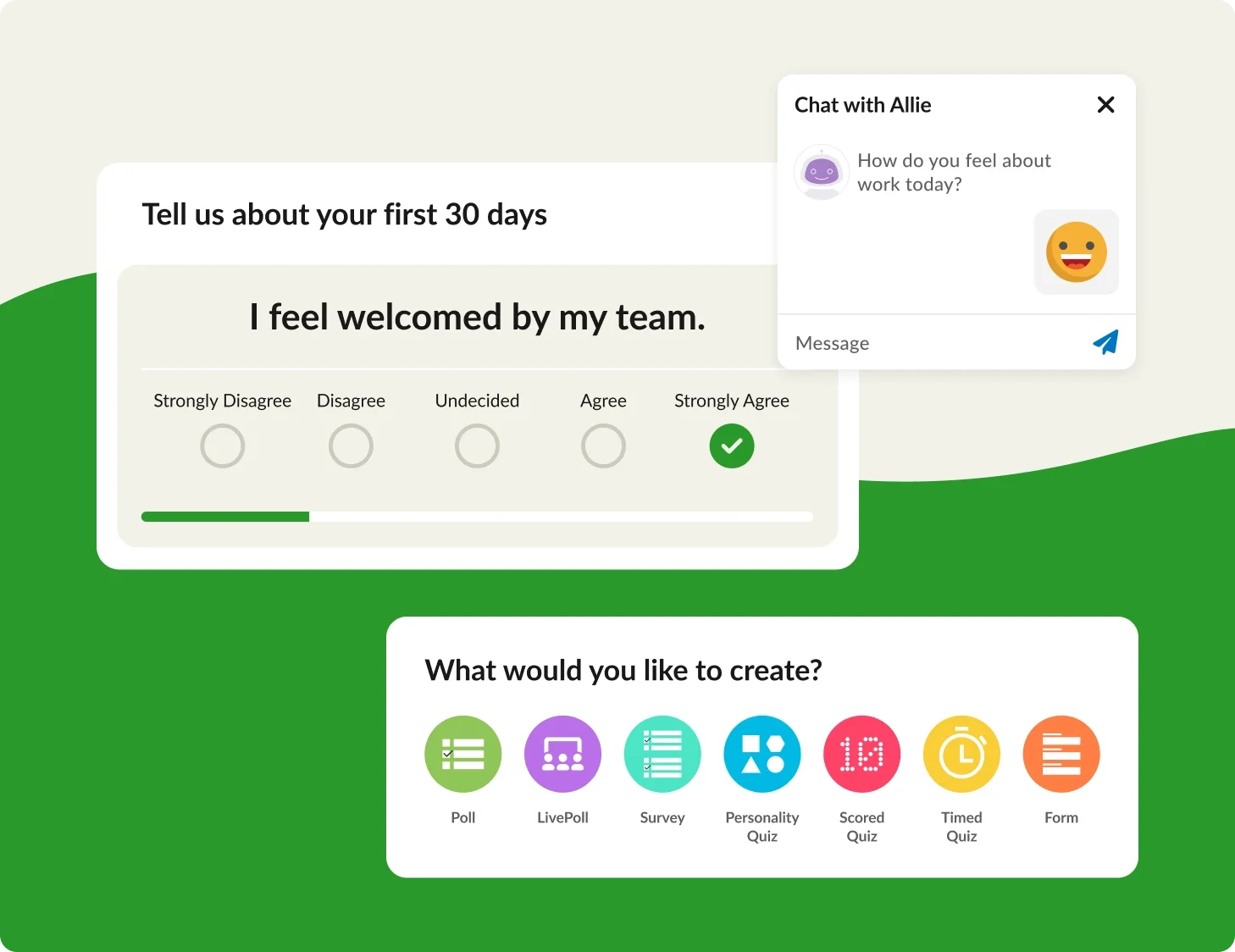
G2 rating: 4.7/5
Strengths:
Achievers is an enterprise-grade platform that connects recognition and feedback in one experience. Its Voice of Employee solution captures feedback across every stage of the employee lifecycle — from onboarding to exit — and turns it into actionable insight. With 100+ customizable templates and flexible survey tools, HR teams can collect the right feedback at the right time.
Real-time dashboards surface trends as they happen, while self-serve reporting makes it easy to explore data and share results. Backed by the deepest recognition data in the industry and seamless HRIS integrations, Achievers helps leaders understand what drives engagement, culture, and retention — and act on it fast.
Best for:
Enterprise organizations that want a unified recognition and feedback platform with advanced analytics and proven business impact.
Key features:
- Employee lifecycle support: Capture feedback across every key moment — from onboarding to exit — for continuous insight into the employee experience.
- Customizable templates: Access 100+ pre-built, research-backed templates that make it easy to gather the right insights at the right time.
- Anonymous feedback: Provide a safe, confidential space for employees to share honest input — increasing trust, candor, and participation.
- Actionable analytics: Spot trends in real time with self-serve dashboards that empower leaders to analyze, share, and act fast.
- Integrated with recognition: Link employee sentiment directly to recognition moments to reinforce behaviors and boost culture alignment.
- Collaborative action planning: Involve managers and teams in follow-up steps to drive accountability and close the loop on feedback.
- Benchmarking: Compare your scores against industry, regional, and engagement benchmarks for added context and clarity.
- Mobile-ready: Ensure full participation with engagement and pulse surveys that are accessible on any device, in any location — no barriers, no exclusions.
- Enterprise integrations: Sync with your HRIS and tools to streamline workflows and turn insight into action faster.
Weakness:
Achievers is built for scale, which may exceed what smaller companies need — but for growing or global organizations, those same capabilities make it a long-term investment.
Review:
“From the moment I joined, I felt genuinely valued and motivated. The platform is intuitive, engaging, and truly built with the user in mind. What sets Achievers apart is its focus on recognition and employee engagement—it’s not just about rewards, but about building a culture of appreciation and connection. The recognition tools are easy to use and incredibly impactful. It’s amazing how a simple “thank you” or shout-out can boost morale and foster a sense of belonging. The rewards catalog is diverse and exciting, offering something for everyone.” — Kyaisia K., via G2
2. CultureMonkey
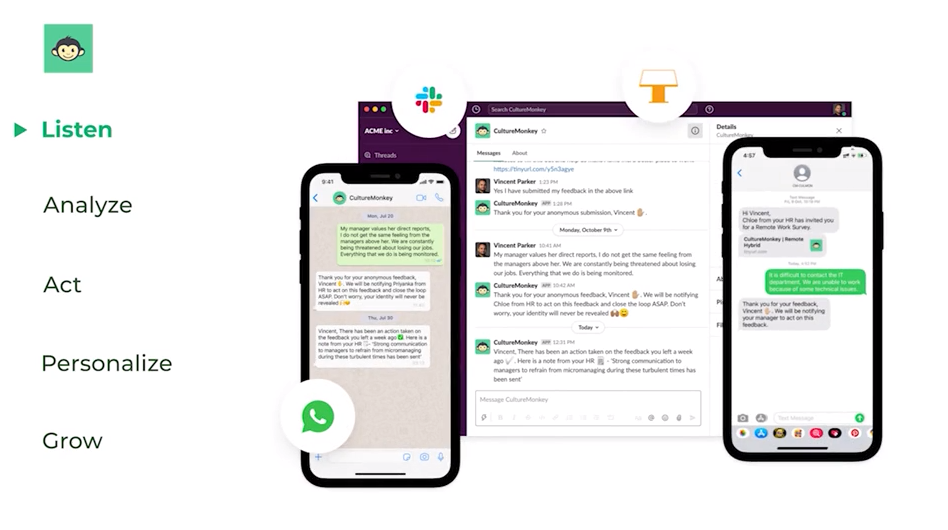
G2 rating: 4.7/5
Strengths:
CultureMonkey helps organizations measure and improve engagement through customizable surveys, anonymous feedback, and AI-powered sentiment analysis. Its platform tracks eNPS and engagement scores, visualizes results with real-time dashboards, and automates survey delivery across the employee lifecycle. The tool supports multiple languages and regions, making it useful for distributed teams.
Best for:
Organizations that need a scalable, data-focused platform to collect employee feedback, analyze sentiment, and guide engagement actions.
Key features:
- Anonymous feedback: Encourage honest input through secure, always-on channels.
- AI sentiment analysis: Instantly classify feedback to spot emotional tone at scale.
- Pulse surveys: Capture frequent, focused insights across the employee lifecycle.
- Feedback-to-action tracking: See what’s been resolved — and what still needs attention.
Weakness:
While strong in measurement, the tool offers fewer features for recognition or continuous performance enablement.
Review:
“Excellent automated tool for all your surveying needs. Very user friendly for team members, and HR administrators, great reporting insights, and excellent customer service from the CultureMonkey team.” — Mandy W., General Manager People, via G2
3. 15Five
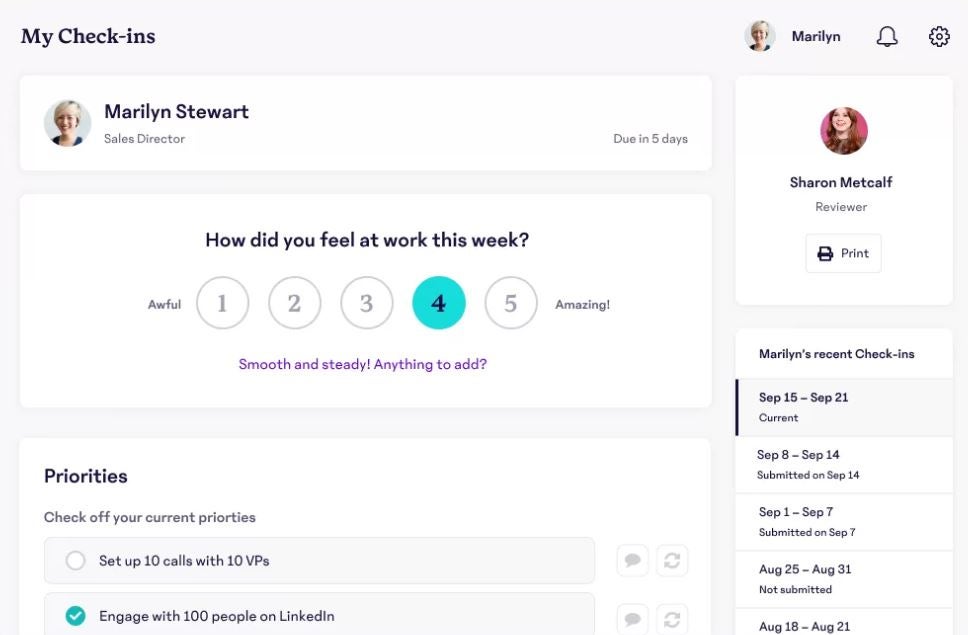
G2 rating: 4.6/5
Strengths:
15Five combines engagement, performance, and manager development in one platform. Its Engage tool uses AI and machine learning to analyze survey data and identify where to take action for the biggest impact. Users can create focused action plans, track progress, and measure outcomes with real-time dashboards. The platform also includes lifecycle surveys, customizable templates, and benchmarks from various survey responses.
Best for:
Organizations looking for a data-driven feedback platform that connects engagement insights to performance outcomes.
Key features:
- Weekly check-ins: Ongoing updates that help managers stay in tune with team progress and morale.
- OKR tracking: Align goals across teams and measure success with built-in accountability.
- One-on-one agendas: Templates for productive meetings focused on development and blockers.
- Performance reviews: Flexible, continuous evaluations based on real-time data.
Weakness:
15Five focuses heavily on analytics and planning but offers limited real-time recognition or integrated engagement features.
Review:
“Overall, I think the reporting is top-tier rivaling that of Workday Peakon and other well respected performance management platforms on the marker. However, the repetitive survey questions over time, coupled with the simple nature of the reward/accolades “high five” feature caused our engagement numbers to do down drastically.” — Justin, Senior Manager, via Capterra
4. ThriveSparrow
![7 Best Practices for Onboarding New Hires [Better Loyalty and Retention]](https://cdn.prod.website-files.com/6488c1e1383b7df38f1064c4/66eaae99a3c51a7e32f6f181_653bb0e5796093d85a44c97d_thrivesparrow-platform-overview.png)
Strengths:
ThriveSparrow helps organizations turn employee feedback into measurable action. The platform combines engagement surveys, performance tools, and collaborative action planning to help managers and teams address key improvement areas. With built-in checklists, task tracking, and performance insights, it provides a structured way to close the loop on employee feedback.
Best for:
Companies that want an easy-to-use engagement and feedback platform with tools to create and manage action plans based on survey insights.
Key features:
- Action plans: Convert survey results into specific, trackable initiatives.
- Performance feedback and reviews: Guide ongoing employee development.
- Pulse and eNPS surveys: Capture recurring insights for continuous engagement tracking.
Weakness:
Organizations seeking deeper analytics or advanced recognition and reward functionality may require a more comprehensive employee experience platform.
Review:
“The only thing I wish was a bit better is the flexibility in customizing reports and survey templates. Sometimes I’d like to tailor them a little more to our internal needs. Also, smoother integration with other HR tools would make it even more powerful.” — Verified review via G2
5. Officevibe
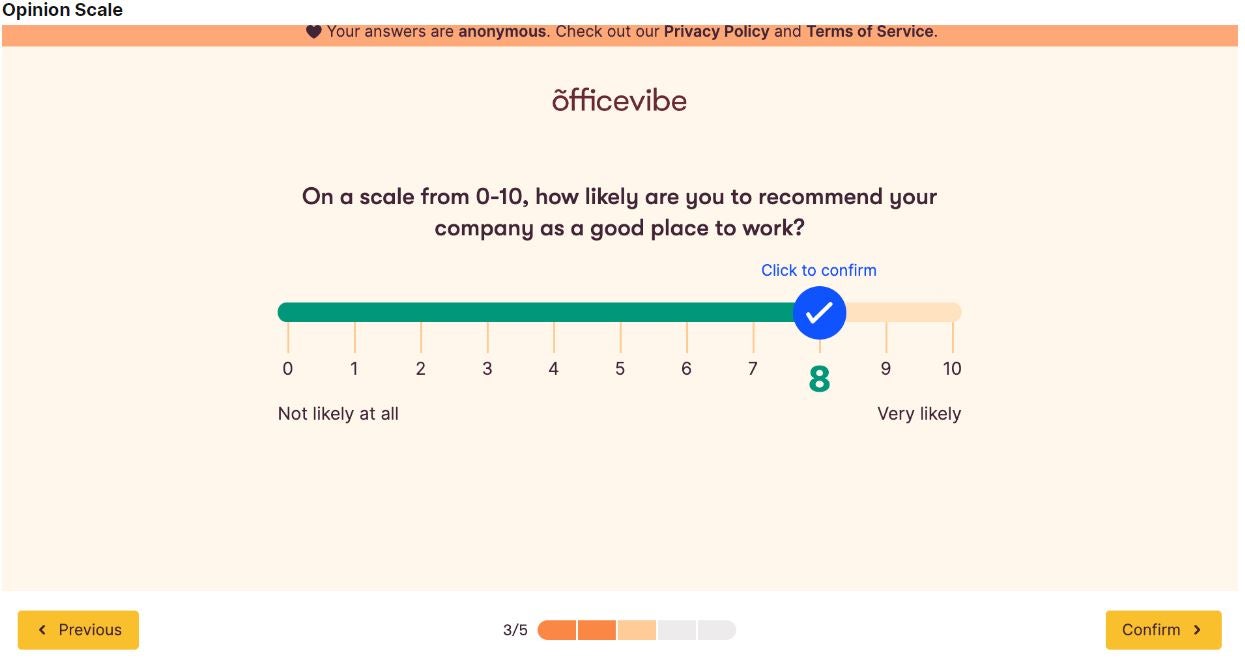
G2 rating: 4.3/5
Strengths:
Officevibe, purchased by Workleap, helps organizations collect and act on employee feedback through pulse surveys, AI insights, and lightweight recognition tools. Its platform supports peer recognition with customizable digital cards, anonymous feedback channels, and manager coaching tools. Built-in AI summarizes feedback, identifies engagement trends, and suggests next steps for managers.
Best for:
Small to midsize organizations that want an easy-to-use engagement and recognition tool focused on surveys, feedback, and light performance tracking.
Key features:
- Pulse surveys: Collect regular feedback on engagement and team health.
- Anonymous input: Enable honest responses to uncover real concerns.
- Real-time analytics: Spot trends and act on them quickly.
- Personalized action plans: Turn insights into targeted next steps.
- Peer-to-peer recognition: Encourage everyday appreciation within teams.
Weakness:
Workleap offers simple recognition tools but limited options for large-scale rewards, advanced analytics, or deep integration into daily workflows.
Review:
“Workleap LMS is definitely easy to use and to implement for businesses looking to centralize their employee training program… There are a couple of features that could be added to make it an even more central tool to an organization, such as incorporating in-person activities into a course plan, for example.” — Marie-Hélène C. via G2
6. Qualtrics
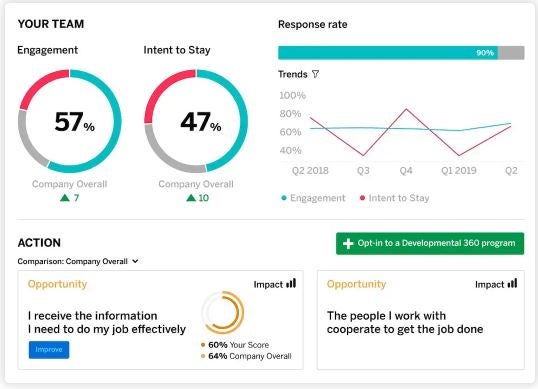
G2 rating: 4.3/5
Strengths:
Qualtrics is an experience management platform that collects and analyzes feedback across employees, customers, and markets. Its Employee Experience suite supports large-scale survey programs, lifecycle feedback, and predictive analytics powered by AI. The platform offers detailed dashboards, automated workflows, and advanced segmentation to help organizations link feedback to engagement and performance outcomes.
Best for:
Enterprises that need a research-grade survey and analytics platform to measure sentiment and drive data-based people decisions.
Key features:
- Customizable surveys: Design and deploy complex survey programs tailored to your organization.
- Sentiment analysis: Use AI to detect emotional tone and trends in written feedback.
- Real-time analytics: Access powerful dashboards and reporting tools for deep data exploration.
- HRIS integrations: Connect to your existing HR systems and workflows.
- Action planning tools: Translate insights into next steps with built-in action tracking.
Weakness:
While its analytics are deep, it relies on traditional survey cycles rather than continuous, in-the-flow engagement like recognition platforms that turn feedback into everyday action.
Review:
“We use Qualtrics for customer feedback management through CSAT surveys. It’s a powerful tool helping us to understand customer feedback and take informed actions to improve customer experience.” — Review via Gartner
7. QuestionPro

G2 rating: 4.5/5
Strengths:
QuestionPro provides a comprehensive platform for collecting and analyzing employee, customer, and market feedback. Its Employee Experience suite includes 360 feedback, lifecycle, and pulse surveys with real-time reporting and customizable templates. The platform supports multilingual surveys, offers advanced data visualization, and provides benchmarking tools to help organizations understand and act on engagement results.
Best for:
Organizations seeking a survey and feedback solution with analytics, customization, and data privacy features.
Key features:
- 360 feedback, pulse, and lifecycle surveys: Gather clear insights across every stage of the employee experience.
- Sentiment analysis and automated reporting: Identify trends quickly with instant reporting.
- Multiple templates and multilingual support: Access a wide range of survey options
Weakness:
QuestionPro emphasizes survey design and analytics but offers fewer tools for driving continuous recognition or behavioral engagement.
Review:
“Pleasantly surprised during our use of QuestionPro just how easy it was to design each questionnaire. Not only does it offer many question formats, the responses can also be designed as needed for each question.” — Samantha, Partnerships and Operations Manager, via Capterra
8. TINYpulse
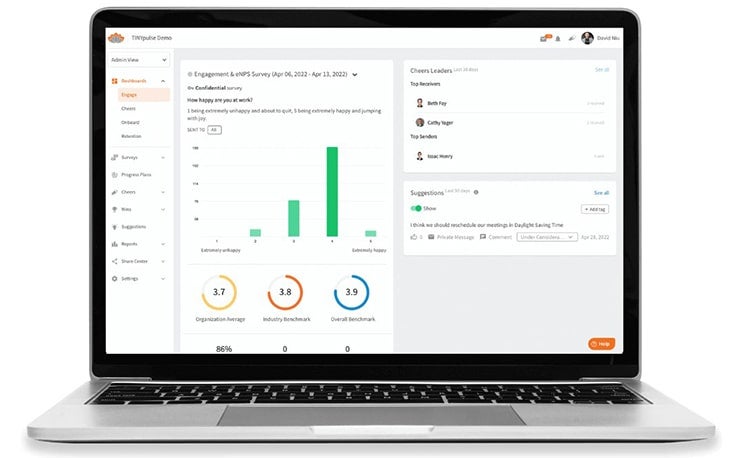
G2 rating: 4.4/5
Strengths:
TINYpulse by WebMD Health Services helps organizations gather feedback and recognize employees through simple, research-backed tools. Its platform includes pulse surveys, anonymous two-way messaging, and recognition features like Cheers for Peers to encourage appreciation across teams. Leaders can track engagement drivers, access analytics, and act on insights with guided action plans.
Best for:
Organizations that want tools for collecting employee feedback, improving communication, and promoting recognition in smaller or mid-sized teams.
Key features:
- Anonymous pulse surveys: Encourage honest, frequent employee feedback.
- Virtual suggestion box: Collect ideas and concerns without friction.
- Peer recognition tools: Celebrate wins and boost team morale.
- Customizable survey templates: Target specific cultural or engagement themes.
- Real-time reporting: Access instant insights to guide quick decisions.
Weakness:
TINYpulse focuses on surveys and peer recognition but offers limited depth in analytics, global rewards, and in-flow recognition experiences. Companies seeking continuous, large-scale recognition and behavioral insights may need a more comprehensive solution.
Review:
“Appreciate that it’s anonymous but that you can still see data from different groups of folks. The pulse surveys have industry data to compare your own with, and it’s easy to select different questions or move them around to show up on different weeks… There are a couple of actions in the interface I wish I could do in fewer clicks, but that’s minor. It’s overall very easy to use and get employee feedback.” — Tina H., Chief of Staff, via G2
9. Quantum Workplace
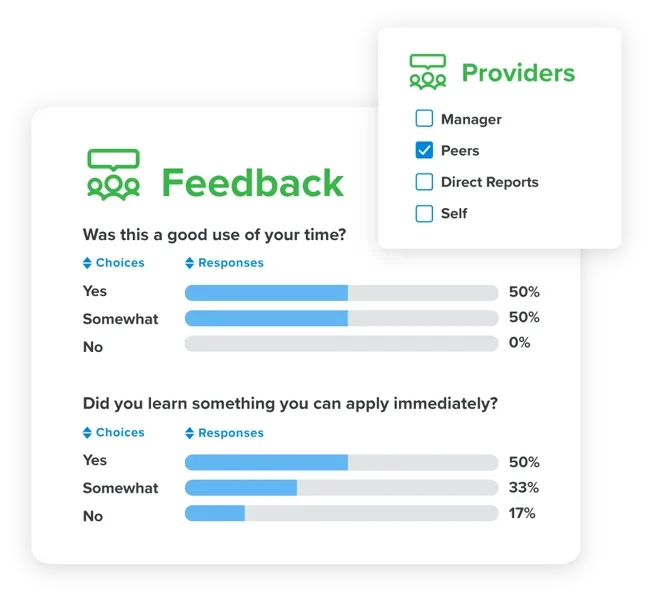
G2 rating: 4.4/5
Strengths:
Quantum Workplace offers an all-in-one platform that connects engagement, performance, and development tools. It includes surveys, goal tracking, 1-on-1s, recognition, and performance reviews in one system. Its feedback tool supports peer and manager feedback, AI-assisted writing prompts, and automated feedback cycles.
Best for:
Organizations seeking a connected performance and engagement platform that links survey feedback, performance reviews, and employee development.
Key features:
- Customizable surveys: Tailor questions to engagement, satisfaction, or performance goals.
- Real-time feedback: Enable on-demand input across teams and reporting levels.
- Pulse surveys: Track sentiment regularly with lightweight survey options.
- AI-assisted feedback writing: Help employees and managers craft meaningful responses.
- Integrated performance reviews: Align feedback with goal tracking and development conversations.
Weakness:
Quantum Workplace emphasizes performance management and structured feedback but offers limited real-time recognition and global reward options.
Review:
“Quantum Workplace tools are easy to use and provide valuable data. We’ve used the engagement survey, feedback, and goals to help improve our culture…In the survey results, the options for filtering and slicing are robust. That means I have to be careful to do it properly and consistently to ensure accuracy in our data.” — Philip, Internal Communications Manager, via Capterra
10. Culture Amp
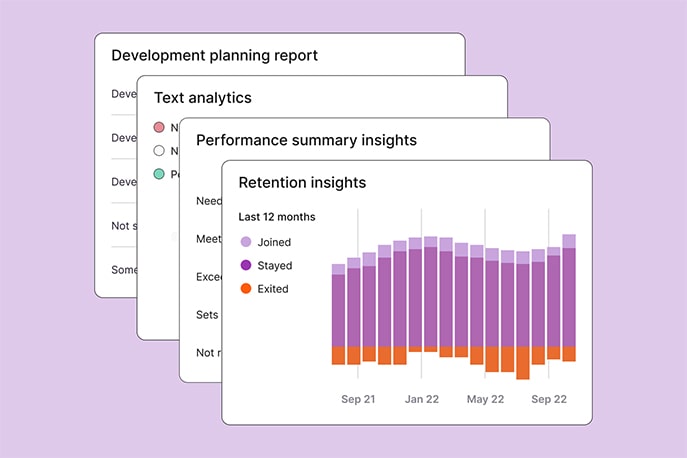
G2 rating: 4.5/5
Strengths:
Culture Amp combines engagement, performance, and development tools in one platform supported by extensive people science research. Its AI-driven features help managers collect feedback, set goals, and track progress through continuous performance conversations. The platform offers 360 feedback, one-on-ones, and ready-to-use survey templates.
Best for:
Organizations that want a research-backed feedback and performance solution with strong analytics and science-based coaching tools.
Key features:
- Customizable and pulse surveys: Gather targeted feedback at scale, across time.
- 360-degree feedback: Support development with peer, manager, and self-assessments
- DEI insights: Measure and track diversity, equity, and inclusion efforts
- Performance management tools: Enable ongoing coaching, goals, and development conversations.
- AI coaching and analytics: Use intelligent recommendations to guide action planning and performance reviews.
Weakness:
Culture Amp focuses on structured performance and survey cycles but offers limited recognition and reward capabilities.
Review:
“Culture Amp is easy to use tool because it has intuitive and modern interface. Its used in our company 3-4 times in year, so employees feel comfortable with that, because they are not urged to use it frequently. I love how this tools allow us to maintain healthy relationship within a team due to its features such as anytime feedback, performance review etc.” — Dmitry D., HRP Specialist, via G2
11. Lattice
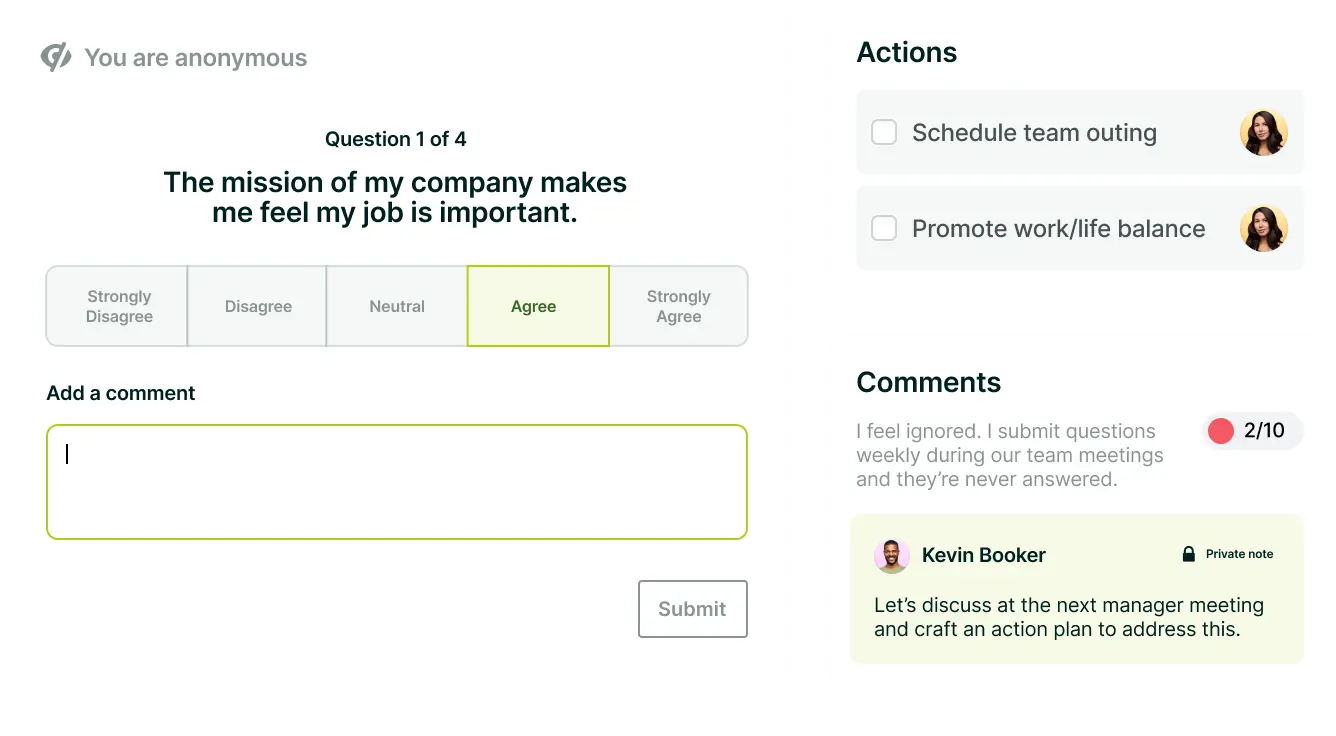
G2 rating: 4.7/5
Strengths:
Lattice combines performance management, engagement, and compensation in one AI-powered platform. It helps HR teams manage feedback, reviews, goals, and pay decisions from a single system. The platform includes built-in analytics, AI writing assistance, and personalized coaching tools to support managers.
Best for:
Organizations seeking a modern HR platform that connects performance, engagement, and compensation within a single system.
Key features:
- Customizable performance reviews: Tailor review cycles to fit your culture and goals.
- 360-degree feedback: Gain insights from peers, reports, and managers to guide development.
- Goal and OKR tracking: Align personal and team goals with broader business outcomes.
- AI-powered coaching and writing tools: Help managers deliver more impactful feedback.
- HRIS and data integrations: Streamline performance and reporting across systems.
Weakness:
Lattice centers on performance and HR processes rather than ongoing recognition or global reward delivery. Teams aiming to build daily engagement and measure the behavioral impact of recognition may find broader recognition-first platforms more effective for long-term culture building.
Review:
“It was quite confusing to fill up the goals and objectives and the way it needed to be updated was quite tedious. I have also heard from the one managing it that sending the feedback from the managers was quite difficult and they had to do it one by one.” — Review via Gartner
12. SurveyMonkey
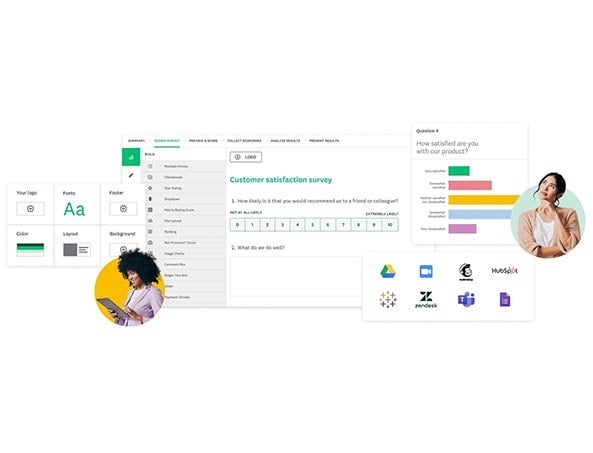
G2 rating: 4.4/5
Strengths:
SurveyMonkey is a leading platform for creating and analyzing surveys across customer, market, and employee experience programs. It offers AI-powered survey creation, sentiment analysis, and automated insights that help teams collect and interpret feedback quickly.
Best for:
Organizations that need a flexible, easy-to-use survey tool for collecting feedback across multiple audiences.
Key features:
- Customizable surveys: Choose from 25+ question types or use expert-designed templates.
- Real-time analytics: Track feedback trends and identify engagement risks as they emerge.
- Anonymous responses: Enable honest employee input without fear of repercussions.
- Easy reporting: Create dashboards and export reports to share insights across teams.
- Tool integrations: Connect with Tableau, Google Sheets, and more for seamless workflows.
Weakness:
SurveyMonkey gathers feedback well, but turning those insights into real action often requires more support.
Review:
“Survey Monkey is a easy to use tool to conduct surveys at large scale and to do the data analysis. The tool has a good user interface and has good capabilities built in to conduct survey with advanced logic… The only thing they need to improve is data presentation once the analysis is done as right now you have to download the data and do you own data visualization.” — Verified review via Capterra
13. Deel

G2 rating: 4.8/5
Strengths:
Deel brings HR, payroll, and engagement together in one connected platform. Deel Engage builds on that foundation with tools that help teams listen, develop, and grow — from AI-powered surveys to career development and training programs. Everything works within the same system used for payroll and compliance, so data and insights flow easily across teams.
Best for:
Companies with distributed or international teams that want to simplify HR operations while keeping engagement and performance in one place.
Key features:
- AI-driven surveys to measure engagement and gather employee feedback
- Career growth and development tools that connect competencies, goals, and training
- Automated learning recommendations to support performance improvement
Weakness:
Deel simplifies compliance and payroll, but doesn’t cover the ongoing recognition moments that drive performance and belonging.
Review:
“Deel is a great company for international nomads. I can work as a coach from all over the world. My earnings arrive in time and in my country’s currency. With the Deel Visa Card I can pay everywhere at any time.” — Review via Capterra
14. Engagedly
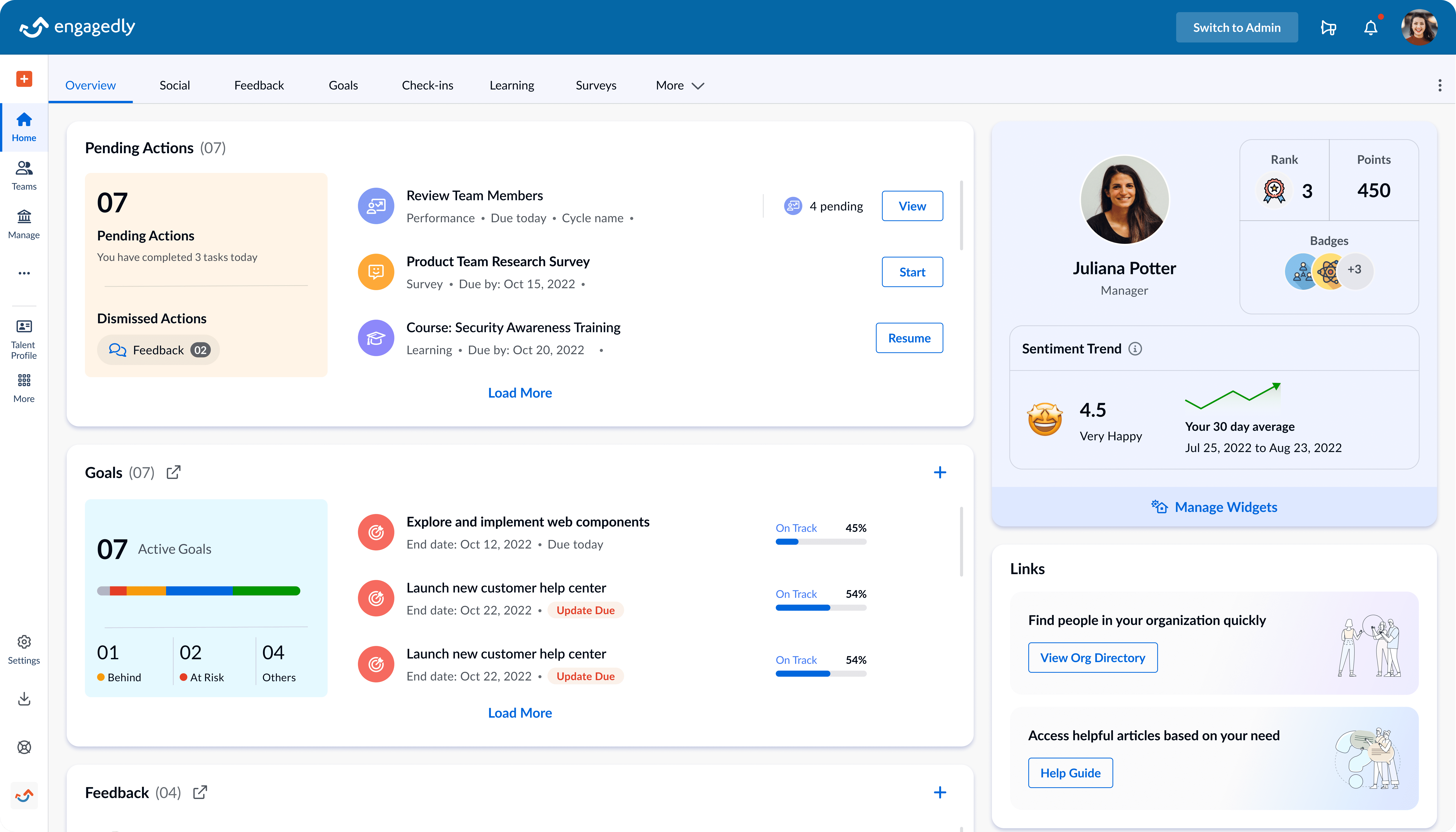
G2 rating: 4.3/5
Strengths:
Engagedly brings performance, learning, engagement, and recognition together in one connected platform. It uses AI and gamification to make development more interactive and feedback more actionable. From goal tracking and 360 reviews to personalized learning paths and real-time engagement insights, Engagedly helps organizations create a more connected, growth-focused culture.
Best for:
Companies looking for a single platform that supports performance, development, and engagement.
Key features:
- AI-powered performance tools: Support OKRs, 360 feedback, and continuous check-ins.
- Personalized learning: Provide recommended courses and skill-based growth paths.
- Engagement and pulse surveys: Capture ongoing feedback with real-time sentiment analysis.
Weakness:
While the platform offers a broad range of features, its recognition and engagement insights focus more on activity than behavioral outcomes. It may not provide the depth of data linking recognition, belonging, and performance seen in more research-driven solutions.
Review:
“The goal setting feature is great and has worked to help evolve how our organization approaches goal setting.” — Verified review via G2
15. Eletive
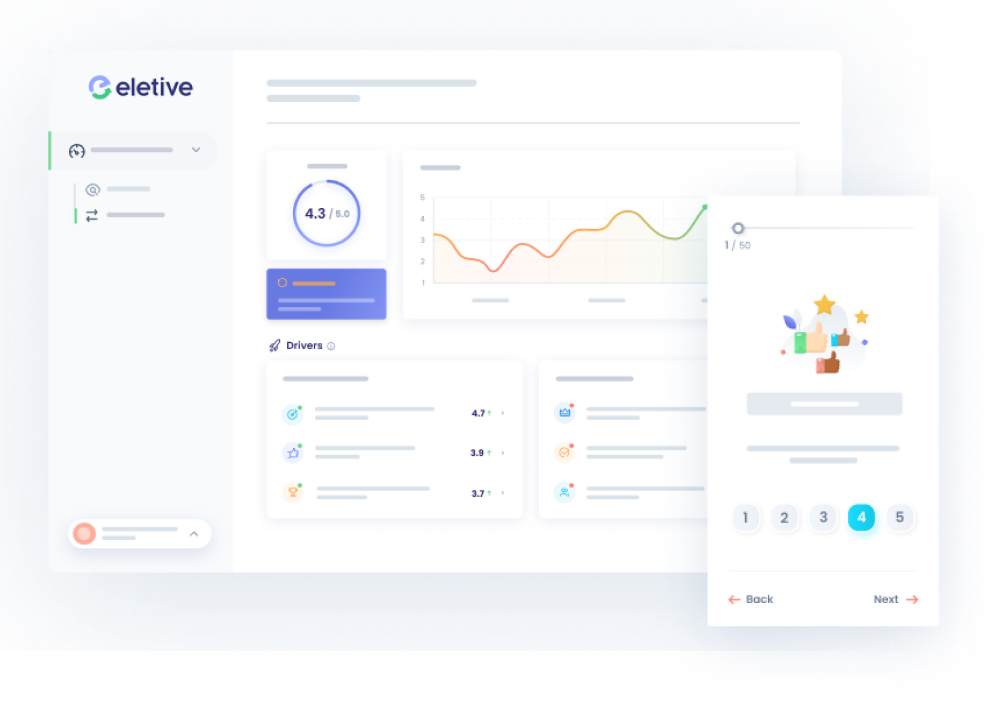
G2 rating: 3.5/5
Strengths:
Eletive combines engagement surveys, performance tools, and AI-driven insights to help organizations strengthen culture and retention. Its platform supports pulse, lifecycle, and targeted surveys — along with anonymous employee chat — giving HR leaders visibility into sentiment and areas for improvement. Features like real-time dashboards and AI analysis make it easy to identify trends and take action quickly.
Best for:
Organizations that want a platform with automated survey tools and analytics for continuous feedback and performance insights.
Key features:
- Pulse and lifecycle surveys: Capture feedback at every stage of the employee journey.
- Anonymous chat: Enable secure two-way communication and psychological safety.
- AI-driven sentiment analysis: Uncover trends and identify engagement risks.
Weakness:
Eletive focuses strongly on surveys and sentiment tracking, but offers fewer tools for turning feedback into ongoing recognition or measurable behavior change.
Review:
“The software works for the basic needs of delivering online learning. There are integrations that are still to come and there are always small quirks to work through and work out of the system, but nothing critical to its efficient use.” — Verified review via Capterra
Benefits of using employee feedback tools
The right software makes it easy to listen often, act quickly, and build a culture that keeps people connected and committed. Here’s what it can do for your organization:
- Real-time feedback, real results: When workloads spike and tech stacks multiply (hello, tool #47), feedback can’t wait for the next engagement survey. Real-time input helps managers spot issues early, support their teams, and keep performance on track. In fact, 45% of employees faced a major workload jump last year, and just as many had to learn new tools. Listening in the moment? That’s how you keep up and show up.
- Better decisions with better data: Gut instinct is great — but data doesn’t lie. Feedback software gives leaders a clear view of what’s really going on, so they can make better calls, faster. Think pulse checks, not guesswork. The result: more targeted action, fewer blind spots, and a workforce that feels seen (and not just during review season).
- A culture that listens: Culture isn’t built in the all-hands — it’s built in the everyday. Regular feedback shows employees their voices matter and gives companies the chance to course-correct before issues become exits. It’s how you turn listening into loyalty — and disengagement into momentum.
- Reduce the risk of turnover: From 2024 to 2025, employee turnover hit 13%, with manager effectiveness and support playing a major role. Feedback software helps catch concerns early, before they turn into goodbye emails. Because retention should be a strategy, not a mystery.
Make Achievers your employee feedback tool of choice
Great feedback tools do more than collect opinions. They cut through the noise, surface what matters, and help you take meaningful action. That’s the real difference between a survey tool and a culture-shaping engine.
Achievers gets you there faster. With always-on feedback channels, 100+ customizable templates, and reporting that actually tells a story, our Voice of Employee solution turns employee insight into organizational impact. Backed by the industry’s richest recognition data set — and seamlessly connected to the tools you already use — it gives HR the clarity, confidence, and speed to lead real change.
*Information and pricing in this blog post was sourced from each vendors website
Key insights
- Modern feedback tools deliver real-time insight, helping leaders act quickly and keep engagement strong.
- Top platforms go beyond surveys, offering anonymity, analytics, and integrations for a clearer picture of employee sentiment.
- Consistent listening boosts culture and retention, giving employees a voice and organizations the data to act with confidence.
| Platform | Best for | Key feature | Integrations | Demo | G2 |
|---|---|---|---|---|---|
| Achievers | Enterprise organizations building culture and performance through continuous recognition and feedback | Unified recognition and Voice of Employee platform with real-time insights and advanced analytics | Workday, Slack, Microsoft Teams, UKG, SAP, LinkedIn, and more | 4.7/5 | |
| CultureMonkey | Organizations collecting and analyzing feedback to understand engagement and sentiment | AI-driven sentiment analysis with automated pulse and lifecycle surveys | Slack, Microsoft Teams, BambooHR, Workday | 4.7/5 | |
| 15Five | Companies linking engagement data with performance management and manager development | AI-powered surveys and performance tools with action planning and progress tracking | Microsoft Teams, Slack, Workday | 4.6/5 | |
| ThriveSparrow | Teams using survey insights to guide performance and engagement improvements | Engagement and eNPS surveys with built-in action planning and task tracking | Slack, Google Workspace, BambooHR | 4.3/5 | |
| Officevibe (Workleap) | Small to midsize organizations gathering regular feedback and peer recognition | Pulse surveys with AI insights, recognition cards, and manager support tools | Microsoft Teams, Slack | 4.3/5 | |
| Qualtrics | Enterprises running large-scale engagement and experience measurement programs | Research-grade survey design with predictive analytics and lifecycle feedback | Workday, SAP SuccessFactors, Salesforce, and more | 4.3/5 | |
| QuestionPro | Organizations seeking a flexible survey and feedback solution with strong analytics and data privacy | Employee feedback and lifecycle surveys with advanced analytics and benchmarking tools | Microsoft Teams, Slack, Salesforce, Workday, API | 4.5/5 | |
| TINYpulse | Small to mid-sized teams collecting feedback and promoting recognition | Pulse surveys, anonymous messaging, and peer-to-peer recognition features | Slack, Microsoft Teams | 4.4/5 | |
| Quantum Workplace | Organizations integrating engagement, feedback, and performance in one platform | Real-time feedback, surveys, and AI-assisted writing and review tools | Microsoft Teams, Slack, Workday | 4.4/5 | |
| Culture Amp | Companies combining engagement and performance tracking with research-backed insights | 360 feedback, pulse surveys, and analytics tools for continuous improvement | Slack, Microsoft Teams, BambooHR, Workday | 4.5/5 | |
| Lattice | Organizations managing performance, engagement, and compensation in a unified system | Performance reviews, goal tracking, and AI-supported feedback tools | Slack, Microsoft Teams, Workday | 4.7/5 | |
| SurveyMonkey | Teams conducting employee and customer surveys at scale | Customizable surveys with AI-generated insights and reporting dashboards | Google Sheets, Tableau, Salesforce | 4.4/5 | |
| Deel | Global organizations managing HR, payroll, and engagement in one platform | AI-driven engagement surveys and development tools integrated with HR operations | Workday, BambooHR, Slack, Microsoft Teams | 4.8/5 | |
| Engagedly | Companies aligning performance, learning, and engagement within a single platform | AI-driven OKRs, 360 feedback, and learning tools with engagement insights | Slack, Microsoft Teams, Workday | 4.3/5 | |
| Eletive | Organizations using continuous feedback to strengthen engagement and retention | Pulse, lifecycle, and targeted surveys with AI sentiment analysis | Slack, Microsoft Teams, BambooHR | 3.5/5 |



